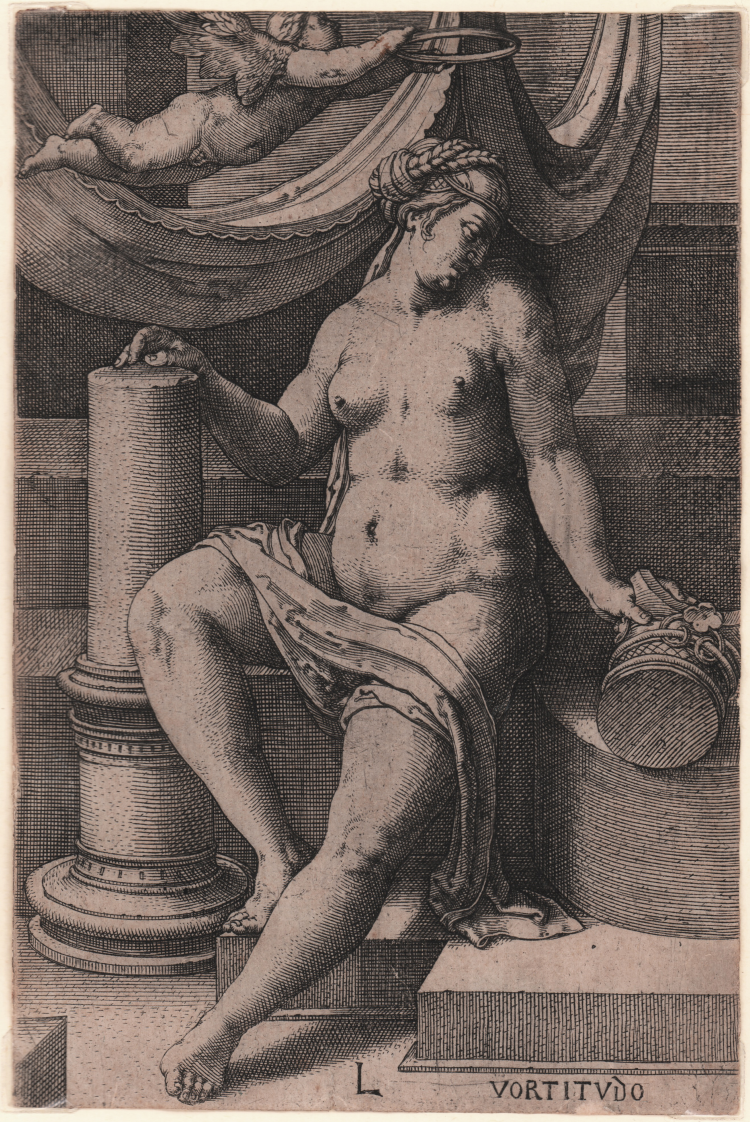




| Reference: | S40261.22 |
| Author | Lucas van LEYDEN |
| Year: | 1530 |
| Measures: | 108 x 162 mm |



| Reference: | S40261.22 |
| Author | Lucas van LEYDEN |
| Year: | 1530 |
| Measures: | 108 x 162 mm |
Engraving, 1530, signed with the monogram "L" and lettered " VORTITUDO" lower right. First state, of three.
Magnificent work, printed on contemporary laid paper, trimmed close to platemark, in excellent condition.
A nude allegorical figure of fortitude sits on a stone bench, looking to the right; her right hand rests on the pillar of a column at left, and her left on the column's capital at right; an angel at upper left holds a halo over her head.
The plate is the sixth in a series of seven plates of the Virtues. Two of the seven plates bear the date 1530.
The Christian Virtues, called theological, were Faith, Hope and Charity, and to the latter the fathers of the church added the four cardinal virtues described in Plato's republic: Justice, Prudence and Temperance. So these subjects treated by the artists as serious, sometimes in contrast to the Capital Vices (which Luke did not perform) were appreciated by the Clergy. Luca, always careful to execute images that could be easily appreciated, worked hard to execute these seven nudes in his Italian style in which the effects of monumentality and all-round are particularly successful.
|
Bartsch VII.420.132; Hollstein 132; Filedt-Kok, 128; The New Hollstein, 132; Salamon, n. 114.
|
Lucas van LEYDEN (Leida 1494 - 1533)
|
Named either Lucas Hugensz or Jacobsz, was a Dutch engraver and painter, born and mainly active in Leiden, who was among the first Dutch exponents of genre painting and is generally regarded as one of the finest engravers in the history of art. He was the pupil of his father, whose works are unknown, and of Cornelis Engelbrechts. They were both painters whereas Lucas himself was principally an engraver. Where he learnt engraving is unknown, but he was highly skilled in that art at a very early age: the earliest known print by him (Mohammed and the Murdered Monk) dates from 1508, when he was perhaps only 14, yet reveals no trace of immaturity in inspiration or technique.
In 1514 he entered the Painters' Guild at Leiden. He seems to have travelled a certain amount, and visits are recorded to Antwerp in 1521, the year of Dürer's Netherlandish journey, and to Middelburg in 1527, when he met Gossaert. An unbroken series of dated engravings makes it possible to follow his career as a print-maker and to date many of his paintings, but no clear pattern of stylistic development emerges. Dürer was the single greatest influence on him, but Lucas was less intellectual in his approach, tending to concentrate on the anecdotal features of the subject and to take delight in caricatures and genre motifs. Carel van Mander characterizes Lucas as a pleasure-loving dilettante, who sometimes worked in bed, but he left a large oeuvre, in spite of his fairly early death, and must have been a prodigious worker.
|
|
Bartsch VII.420.132; Hollstein 132; Filedt-Kok, 128; The New Hollstein, 132; Salamon, n. 114.
|
Lucas van LEYDEN (Leida 1494 - 1533)
|
Named either Lucas Hugensz or Jacobsz, was a Dutch engraver and painter, born and mainly active in Leiden, who was among the first Dutch exponents of genre painting and is generally regarded as one of the finest engravers in the history of art. He was the pupil of his father, whose works are unknown, and of Cornelis Engelbrechts. They were both painters whereas Lucas himself was principally an engraver. Where he learnt engraving is unknown, but he was highly skilled in that art at a very early age: the earliest known print by him (Mohammed and the Murdered Monk) dates from 1508, when he was perhaps only 14, yet reveals no trace of immaturity in inspiration or technique.
In 1514 he entered the Painters' Guild at Leiden. He seems to have travelled a certain amount, and visits are recorded to Antwerp in 1521, the year of Dürer's Netherlandish journey, and to Middelburg in 1527, when he met Gossaert. An unbroken series of dated engravings makes it possible to follow his career as a print-maker and to date many of his paintings, but no clear pattern of stylistic development emerges. Dürer was the single greatest influence on him, but Lucas was less intellectual in his approach, tending to concentrate on the anecdotal features of the subject and to take delight in caricatures and genre motifs. Carel van Mander characterizes Lucas as a pleasure-loving dilettante, who sometimes worked in bed, but he left a large oeuvre, in spite of his fairly early death, and must have been a prodigious worker.
|